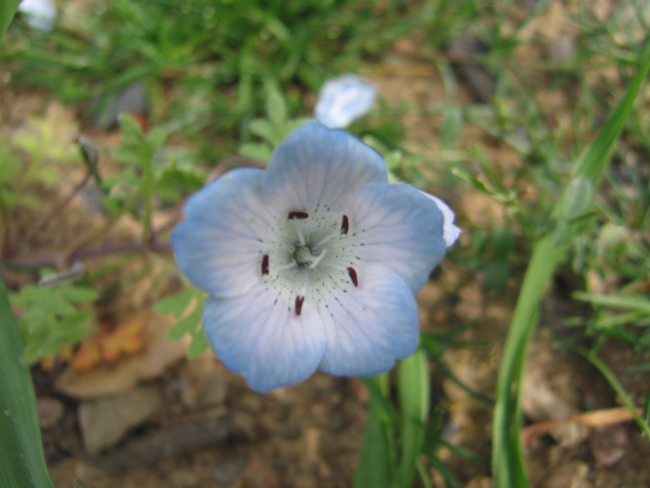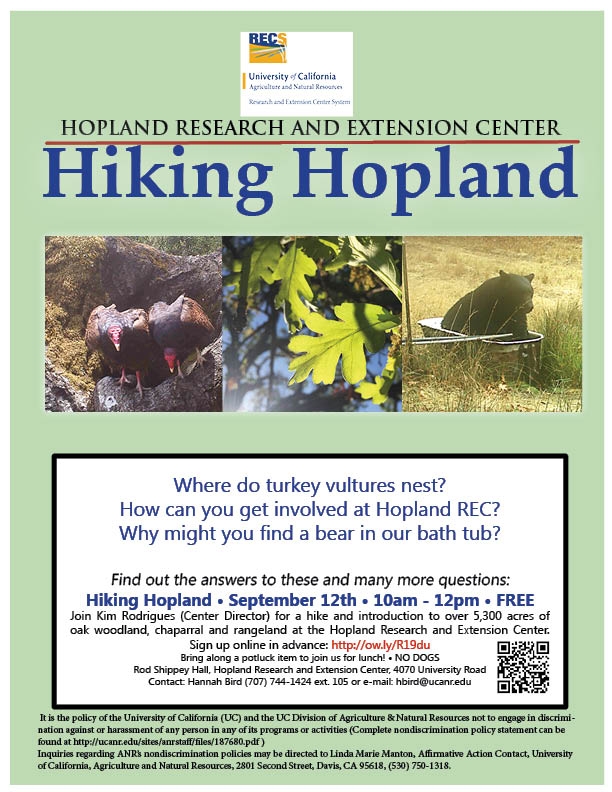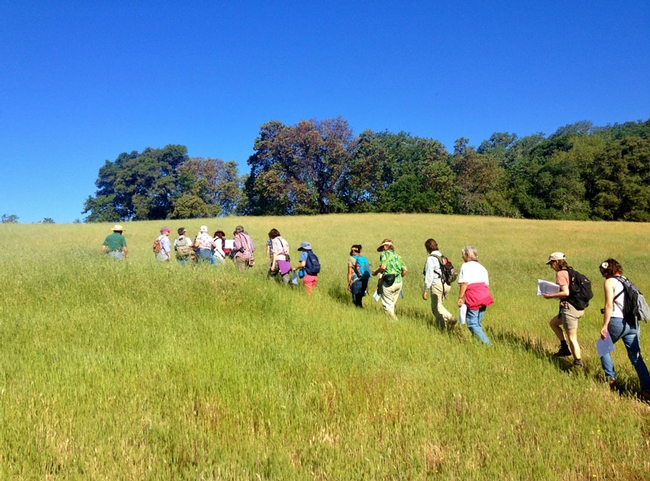- Author: Hannah Bird
As one of the 9 UCANR Research and Extension Centers (RECs) across California, Hopland REC offers opportunities for research projects across a variety of disciplines particularly those requiring rangeland, oak woodland and chaparral environments. While respecting that need we also have the desire to behave as exemplary stewards of the land, setting examples and raising awareness as we change and improve our methods.
One important lesson that has allowed us to learn and spread knowledge has been from the history of our site. Dr. Donna Gillette has conducted research at HREC since 2006 when it became evident that some of the ancient petroglyph style markings to be found on the 5,358 acre site were likely to be over 2000 years old. Many of these markings take the form of circles carved into large rocks and are described as “Pecked, Curvilinear, Nucleated” markings (PCN's). Following Dr. Gillette's work we discovered that these markings were in fact between 5-8000 years old, pre dating Pomo culture (as we know it).
This fascinating research led us to ask questions about what kind of behavior is appropriate around such important discoveries. Can we touch these markings without degrading them further? Can we show them to the public? How do our Tribal partners feel about such finds? How do they affect land management decisions?
Our own journey led us to work more closely with our local Tribal Historic Preservation Officer (THPO), Shawn Padi of the Hopland Band of Pomo Indians. This partnership has most recently contributed to our “Archaeology for All” event, featuring both archaeologist Dr. Gillette and THPO's Shawn Padi and Hillary Renick on Saturday, October 10th. This event was planned in close collaboration with the Society for California Archaeology, the mini grant that we received enabled us to support the travel costs of our wonderful volunteer speakers, while the Hopland Band of Pomo Indians provided the lunch.
Over 100 members of the public and 30 children attended this event at which we discussed our local history, cultural markings that might be found on our landscape and why it is important to leave any discoveries of artefacts or markings just as you find them and report to your local THPO. Children got the chance to become archaeologists themselves and saw directly how difficult it can be to piece together our history when pieces of the story might have been removed or broken!
Piecing the past together – students try to put together the pieces of broken pottery they have located and mapped – it's not always easy when others have taken some of the pieces as keepsakes.
The challenge of balancing current demands from our natural resources and culturally important sites can be complex. However learning from the history of people in our area is a vital step in understanding sustainable use and behavior for the future. The Hopland Research and Extension Center have benefitted greatly from relationships such as those with local THPO's, their knowledge is integral future land management decisions.
- Author: Hannah Bird
A little late in the month, but here is our August newsletter!
http://us10.campaign-archive2.com/?u=32b1d74684fe8cfb160cb78a8&id=8ad396ce85&e=[UNIQID]
And more about our upcoming "Hopland Hikes" event:
"Over 5,300 acres of oak woodland, chaparral and rangeland will be opened up on Saturday, September 12th from 10am-12pm for a guided public hike at the Hopland Research and Extension Center. Dr. Kim Rodrigues the Center Director will guide visitors on a 2 hour hike and share some of the exciting research and education activities, how the public can get involved at the site and where bears like to bathe!
This black bear has been captured on trail camera, enjoying a break in one of the water troughs at HREC, during a study conducted by Dr. Justin Brashares which examines how wildlife movement is affected by fencing.
“The Hopland Research and Extension Center (HREC) is one of 9 centers across the state owned by the University of California Agriculture and Natural Resources division. This is a great opportunity for the public to visit the site and learn about the important research that has been conducted here over the last 60 years. Research projects have encompassed many different disciplines ranging from Dr. Bob Lane's groundbreaking research into Lyme disease and other tick borne diseases to Dr. Donna Gillette's work on ancient petroglyph style markings on the site, found to be over 5000 years old! This is a great opportunity for the public to visit this beautiful property, we are also hoping to build a community of docents to help run these hikes on a monthly basis in 2016. There is so much to see on the site we can't cover it all in just one hike!” Commented Hannah Bird, Community Educator at HREC.
Participants are encouraged to wear clothing suitable for hiking whatever the weather and to bring a water bottle. Hikes will take place on roads or trails – but terrain may be steep and uneven at times. No dogs are allowed on the hike due to the presence of guard animals on the site used for sheep protection.
Those who would like to share a potluck lunch after the hike are encouraged to bring along plates, utensils, cups and an item of food to share.
This is a free event but participants are encouraged to sign up in advance at: http://ow.ly/R9BJo . Hikers will meet at the Rod Shippey Hall, 4070 University Road, Hopland CA 95449 at 10am on Saturday, September 12th. For more information contact Hannah Bird, (707) 744-1424, Ext. 105, hbird@ucanr.edu.
- Author: Hannah Bird
As many of you are no doubt already aware, the end of June marks the end of over 30 years of dedicated service by Bob Keiffer to the Hopland Research and Extension Center. Bob has been the brains and eloquence behind this blog since it's inception and we hope to continue to feature him as a guest writer into the future.
You can enjoy comments from some of the various researchers with whom he has worked by taking a look at our most recent newsletter: http://us10.campaign-archive2.com/?u=32b1d74684fe8cfb160cb78a8&id=0d5c177fbf&e=[UNIQID]
The Hopland REC blog will continue with entries from various staff and researchers to keep you up to date on recent discoveries, events and opportunities.
If you have a topic or area of interest that you hope the blog will cover, please comment and let us know.
In the mean time I am sure you would all join me in wishing the wonderful Bob K. some well earned relaxation and perhaps a sighting of an ivory billed woodpecker! Here's hoping!
- Author: Hannah Bird

Those enjoying a visit to the HREC Rod Shippey Hall for our various functions and trainings may spot these beautiful white flowers peeking out right along the trail to the hall. What you may not realize is that you are in fact walking in the area that this new species was discovered only recently.
This species of Nemophila growing sympatrically in Mendocino and Napa counties with a closely related species (Baby Blue eyes) was discovered at Hopland Research and Extension Center a few years ago. The new species, Nemophila hoplandensis, differs from Nemophila menziesii var. atomaria in both floral and vegetative color. The corollas of N. menziesii var. atomaria range from deep blue to a bluish white. Nemophila hoplandensis has large and unusually bright white corollas and vegetative structures that are a brighter green than those of N. menziesii var. atomaria. Controlled crosses were made in order to ascertain these populations were a new species; despite sharing pollinators N. hoplandensis is reproductively isolated from N. menziesii var. atomaria via failure of hybrid seed production following artificial crosses. Molecular phylogenetic analyses also clearly differentiate N. hoplandensis within the genus. The newly described species, currently known only from Mendocino and Napa counties, has a range that is more restricted than, and lies within the range of, N. menziesii var. atomaria.
Just one example of the many areas of research that are carried out at HREC, this particular species was discovered by the late Camille Barr. Nemophila hoplandensis is blooming right now, giving you the perfect excuse to join one of our public events such as the 4H fundraiser 5K fun run “Color Me Green” on March 28th or our special event “Earth Day in the Vineyard” on April 22nd focusing on new practices for vineyard floor management and soil health. Come join us and take a look at this new species for yourself…

- Author: Robert J Keiffer
- Contributor: Brook Gamble
Registration is now open for the third Inland Mendocino UC California Naturalist Program certification course taught by Dr. Jennifer Riddell. This is a nature enthusiast's ticket to explore Hopland Research and Extension Center's 5,358 acres of oak woodland, grassland, chaparral, and riparian environments! The 40 hour course combines a science curriculum with local guest experts, field trips and project'based learning to explore the unique ecology and natural history of inland Mendocino County.
The class covers basic ecology, watershed concepts, geology, wildlife, plants, and global environmental issues, as well as tools for collaborative conservation and communication. Class meets every Monday evening for 8 weeks. Five field trips take place largely at the Hopland Research and Extension Center with some visits to Low Gap Park and other local highlights. Upon completing certification requirements, participants are eligible for four academic credits through UC Davis Extension.
Most California Naturalists enjoy volunteering or career tracks as stewards, interpreters and teachers, data collectors, and managers/technicians for restoration projects with land management, informal education, and conservation organizations. To date, Inland Mendocino California Naturalists have volunteered 1,517 service hours in our community in areas of education/interpretation, conservation/restoration, citizen science, and program support to local non-profits and educational institutions.






